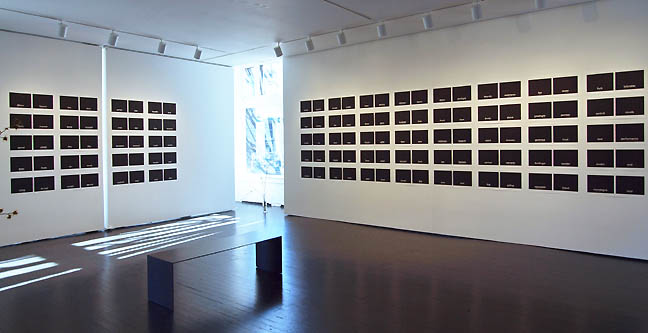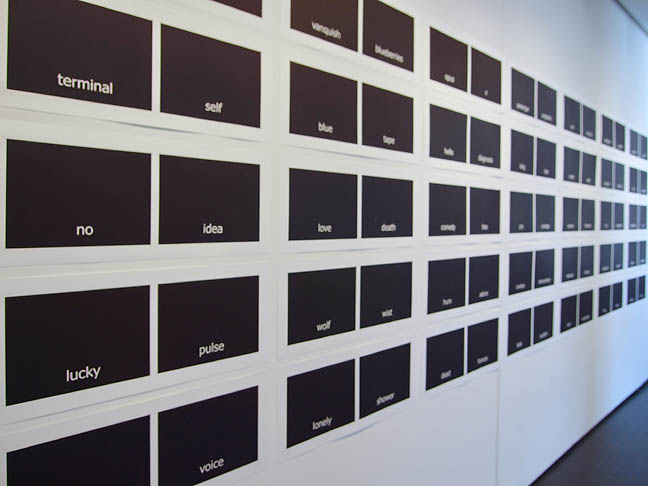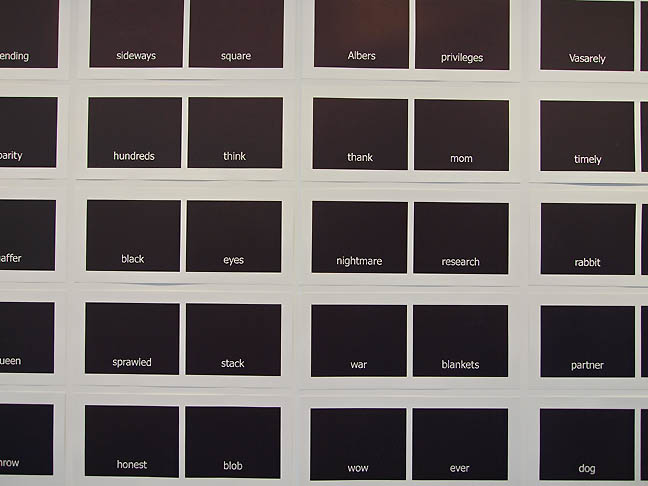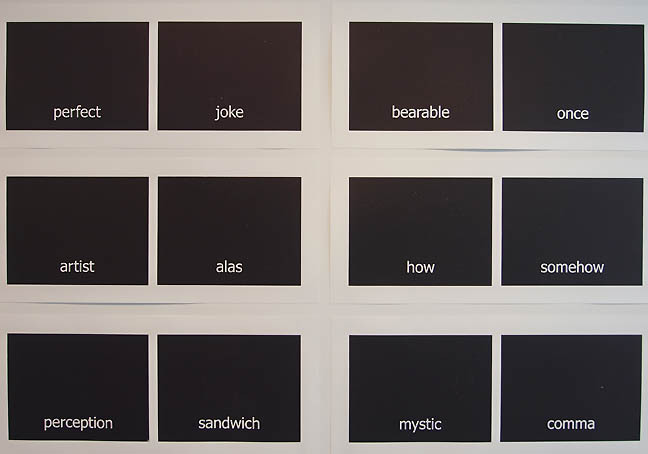
|
||
|
Portland art blog + news + exhibition reviews + galleries + contemporary northwest art
|
||
Victoria Haven's Subtitles at PDX  Subtitles by Victoria Haven at PDX Contemporary (photos Jeff Jahn) Everyone, left to his own devices, forms an idea about what goes on in language which is very far from the truth -Ferdinand de Saussure I'm not sure if I was able to "enter a void-like state" as per the request of the press release for Victoria Haven's "Subtitles" at PDX Contemporary but I can assure you that there were certainly moments of quiet reflection and introspection. With one hundred sets of wood block prints done in four editions, the amount of labor involved is on its own worth mentioning. Each individual part to this extensive whole is made up of two laser etched wood blocks printed together in jet black ink with one single word set low enough in the composition to suggest the name sake of the show. "Subtitles" is a slow dance with semiotic principals where in which the Art is found through the relationship of two seemingly unrelated words. 
The malleability of words is something that has always been beautiful to me and I have always enjoyed playing around with the context of certain words in order to manipulate their meaning. One might say that "Subtitles" was tailor made for someone like me. 
Though the idea of word as image is not new to contemporary art I must say that I found this project exceedingly more interesting than similar works like On Kawara's "today". A series of paintings that were made throughout the artist's life where the artist plainly paints the date on a variety of standard sized canvass. For me, the cleverness of his concept doesn't engage me long enough to really appreciate anything beyond the absurdity of the work. In contrast to the ordinariness of her predecessors, via the process of association, Haven has given us many opportunities to become engaged and to foster a deeper more personal connection. 
Though some of the pairings are cheeky and mischievous like monster/proof and generous/trout others are more suggestive and seem to come preloaded with tension and narrative black/eyes. Whatever the case may be, the invitation is clear; sit, reflect, compare and let your mind wander. Allow yourself to make odd connections and take the time to appreciate the juxtaposition of two seemingly unrelated words. Enjoy the magnitude of the project and pause for a moment. Overall, I feel like this collection works as a whole but I can't help but to wonder if the concept holds up when it is broken into parts. Which is to say, away from a gallery setting do these prints still carry the same oomph or will they come across like some bargain bin frame that someone forgot to take the stock image out of? In closing I ask- What would Saussure say about all of this? Have we bastardized his baby? Subtitles runs through January 31st (tomorrow) Posted by Christopher Moon on January 30, 2015 at 14:40 | Comments (3) Comments On another matter, being in a room of On Kawara's work in the right space, like Dia Beacon, is somewhere between mind-blowing and transcendent. In terms of 'getting' this installation, it seems the artist's statement is an important reference because it explains the sort of post-structuralist message the pairings suggest by being both "binaries" and "randomly paired" at the same time - as well as the interesting signification of these digital texts as they're transformed into prints on paper (like an inscribing of techno-phonic signifiers into writing) through what is ostensibly an older technology of block printing but which was actually done using newer technology of laser etching. Instead of the pairings of the words, I'd suggest the "art is found" through these processes of deconstructing the digital texts into signs, taking those signs and using them to make a physical artifact/installation/foot(print) of the never ending chain of deferred signification, deferred meaning, so that this is maybe less about Saussure and more toward, if not about, Derrida. Making this contemporary, digital speech into "tactile, physical form" is really making it into writing. Saussure warned about the danger of writing, the tyranny of writing, as did Plato - and Philosophy has a long history of a debasement of writing. In that sense, the artist asks some interesting questions about what happens when we write down our new digital forms of speech. From tenuous digital words to tenuous signification, where is the intelligible meaning in writing? When the reviewer interprets the pairings as "cheeky and mischievous" or "suggestive and [...] preloaded with tension and narrative" it makes this point quite well because we learn from reading the artists statement that the artist used a "computer algorithm program [...] to create a continuous random pairing of the words." Posted by: MOR I see both of you asserting similar ideas. The anticipation of language and the anticipation of space shapes experience and can also be seen as the tyranny of language and/or space. It can also be freedom if that is the anticipated response. Criticism tests the work and it is too rare these days. What's more if someone expects to like a show or a writer's review the viewer/reader (is there a difference?) the anticipatory bias colors the reception. This anticipatory bias is something Haven is playing with... which brings up the old lat 60's and 70's trend of art that acts more like an study in empiricism than some masterpiece game. It is that field of equivalent response outcomes that acts like freedom. It is also related to Euclid's Orchard with a language overlay... instead of trees. For example, Haven's show at PDX is displayed within an elegant Brad Cloepfil designed space and the On Kawara at Dia Beacon was designed by none other than Robert Irwin (whom influenced Cloepfil). There is a great emptying of details, which allows viewers to bring their own baggage to the void. Perhaps it is the void itself which is truly lost in translation? It is why I like the tone of the opening quote... the test is in exploring the baggage we bring to our misunderstandings (an old critic/curator's trick). Still, no exhibition should require reading theartist's statement... strong work is still strong even when disliked or misunderstood... Chris clearly likes and understands the show and I like his personal approach to exploring his reaction... rather than parroting the press release with more eloquence (it is a trend that is really hurting contemporary art). I feel like this age of ours has somehow morphed into an era ruled by the idealogue impulse where the internet's infinite feedback loop shrinks the proximity of agreement and disagreement but an exhibition lets us inhabit our own atmosphere for a little longer... enough to question ourselves. Somehow only art is allowed to troll us in a benign way? Generally the art isn't data mining us... not always true though. Posted by: Double J Fascinating fact about the Cloepfil/Irwin connection - and mirroring the discussion that is a great example of a pairing of things I knew/didn't know. I love Haven's show (as much as I've seen and read remotely) - but I didn't at first. I think my first impulse matched the review, my second matched my notes above. I do think this is still highly conceptual work, because process and statement are SO important to getting into the message of it. More conceptual than On Kawara's date painting in fact because in the case of the those you have all these moments in time, captured as durations with subtle variation, whereas in this case you have that only in the knowledge of the process, but not in the product. Although I noticed on the web site there are pieces printed on vellum which are quite different from those on paper and I'd like to know more about that distinction too. Posted by: MOR Post a comment Thanks for signing in, . Now you can comment. (sign out)
(If you haven't left a comment here before, you may need to be approved by
the site owner before your comment will appear. Until then, it won't appear
on the entry. Thanks for waiting.)
|
| s p o n s o r s |
 |
 |
 |
 |
 |
 |
 |
 |
 |
 |
 |
 |
 |
 |
 |
 |

|
Site Design: Jennifer Armbrust | • | Site Development: Philippe Blanc & Katherine Bovee | |


![[TypeKey Profile Page]](http://www.portlandart.net/nav-commenters.gif)